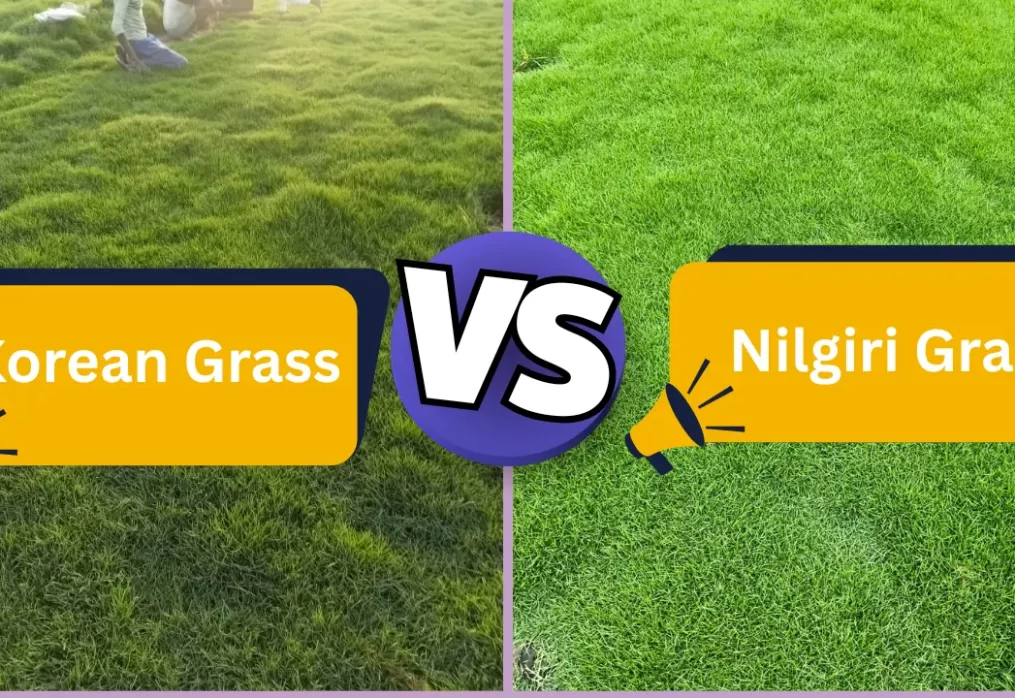Korean Grass vs Nilgiri Grass – Look, Price & Maintenance Compared
Introduction
Choosing the right lawn grass is like choosing the right paint color for your home – it sets the tone for everything. Among popular options in India, Korean Grass and Nilgiri Grass are often compared. Both are widely used for lawns, gardens, parks, and landscaping projects. But which one is better for your needs? Let’s break it down by looks, price, and maintenance.
Overview of Korean Grass
Korean Grass, also known as Zoysia tenuifolia, is a fine-textured, carpet-like grass. It’s a favorite among homeowners who want a lush, ornamental lawn.
- Origin: Native to Southeast Asia
- Appearance: Soft, thin blades with a dense carpet finish
- Climate Suitability: Prefers warm, sunny conditions but tolerates some shade
- Common Uses: Decorative lawns, gardens, pathways where aesthetics matter
Overview of Nilgiri Grass
Nilgiri Grass is a popular Indian turfgrass, widely grown for its resilience and affordability.
- Origin: Grown across Indian plains and hill regions
- Appearance: Slightly broader blades, light green shade
- Climate Suitability: Thrives in Indian climates with minimal care
- Common Uses: Parks, playgrounds, roadside lawns, budget-friendly lawns
Visual Differences Between Korean and Nilgiri Grass
- Korean Grass: Rich green, soft, and uniform. It looks like a natural carpet.
- Nilgiri Grass: Lighter green, coarser blades, and less dense.
If you want a picture-perfect luxury lawn, Korean grass is unbeatable. Nilgiri grass, on the other hand, looks simple but serves its purpose well.
Growth Rate and Coverage
- Korean Grass: Slow-growing, which means less mowing but takes time to cover empty patches.
- Nilgiri Grass: Fast-growing, spreads quickly, and covers ground in weeks.
If you’re in a hurry to green up your lawn, Nilgiri is the winner.
Comfort and Usage
- Korean Grass: Extremely soft, ideal for barefoot walks, yoga, or decorative lawns.
- Nilgiri Grass: Slightly rougher, better for heavy-use areas like playgrounds or parks.
Durability and Wear Resistance
- Korean Grass: Doesn’t handle heavy traffic well. Best for low-use lawns.
- Nilgiri Grass: Can withstand kids playing, pets running, and regular foot traffic.
Price Comparison
- Korean Grass: ₹80–₹120 per square foot (premium option).
- Nilgiri Grass: ₹25–₹50 per square foot (budget-friendly).
Korean grass is a luxury choice, while Nilgiri grass is economical for larger lawns.
Water Requirements
- Korean Grass: Needs frequent watering to stay lush.
- Nilgiri Grass: More drought-tolerant, survives with moderate watering.
Fertilization and Nutrient Needs
- Korean Grass: Requires high-quality fertilizers for its dense growth.
- Nilgiri Grass: Needs minimal fertilization, grows well in average soil.
Maintenance Needs
- Korean Grass: Low mowing but requires meticulous care for pests and watering.
- Nilgiri Grass: High mowing frequency but easier overall care.
Pest and Disease Resistance
- Korean Grass: Susceptible to fungal infections if overwatered.
- Nilgiri Grass: More resistant, hardy, and less prone to diseases.
Climate Suitability in India
- Korean Grass: Ideal for Delhi, Chandigarh, and ornamental lawns in urban areas.
- Nilgiri Grass: Adaptable across India – from plains to hilly regions.
Pros and Cons of Korean Grass
Pros:
- Luxurious look
- Soft texture
- Low mowing requirement
Cons:
- Expensive
- Slow growth
- Not ideal for heavy traffic
Pros and Cons of Nilgiri Grass
Pros:
- Affordable
- Fast growth
- High durability
Cons:
- Coarser texture
- Requires frequent mowing
- Less premium appearance
Which One Should You Choose?
- Choose Korean Grass if: You want a luxury, soft, carpet-like lawn and don’t mind investing more time and money.
- Choose Nilgiri Grass if: You want a practical, budget-friendly, and durable lawn that’s easy to maintain.
Conclusion
Both Korean Grass and Nilgiri Grass have their strengths. Korean grass is like a velvet carpet – elegant but delicate. Nilgiri grass is like a rugged mat – not as pretty, but tough and affordable. Your choice depends on your budget, the look you want, and how much maintenance you’re willing to put in.
FAQs
Q1. Which grass is better for hot Indian summers?
Nilgiri Grass performs better in heat and requires less water compared to Korean Grass.
Q2. Can I use Korean Grass for playgrounds?
Not recommended, as Korean Grass can’t handle heavy foot traffic.
Q3. Is Nilgiri Grass good for small decorative lawns?
It works, but if aesthetics matter more, Korean Grass is a better choice.
Q4. Which grass type needs less mowing?
Korean Grass grows slowly, so it needs less mowing compared to Nilgiri Grass.
Q5. Which grass lasts longer with minimal care?
Nilgiri Grass is hardier and easier to sustain with minimal effort.
Last Updated on 2 months ago by Anjali Mehra Ph.D. in Horticulture (Punjab Agricultural University)
- How to Keep Your Gurgaon Lawn Green During Winters - November 15, 2025
- Fast-Growing Grass Types for Farms and Villas in Punjab - November 13, 2025
- Bermuda Grass vs Selection No.1 Grass — Gurgaon Buyers’ Guide - November 10, 2025
